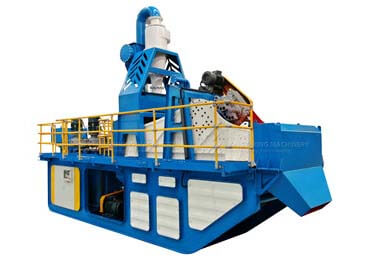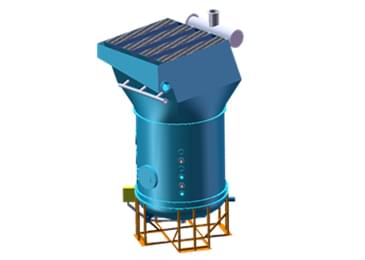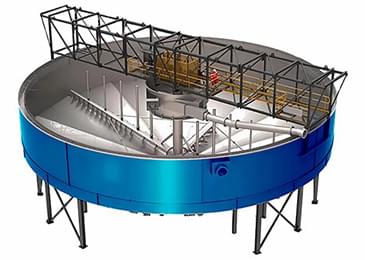How to solve the five problems of hydrocyclones
2021-07-03
The hydrocyclone is a more effective fine-grain classification equipment in the current mineral processing equipment. In daily production, the hydrocyclone will more or less have some equipment failures. If it can not be found and solved in time, it is likely to cause the hydrocyclone to stop. So, what are the common faults of hydrocyclones in daily operation? How can we solve these failures? This article starts with five common faults and analyzes their causes and countermeasures.
1. Large fluctuations in the pressure on the mine
In the production process, the feed pressure will affect the processing capacity and grading particle size of the hydrocyclone. Generally, the feed pressure of the hydrocyclone should be kept stable as required, and no large fluctuations should occur, otherwise, it will damage the performance of the equipment and affect its classification effect. The large fluctuation of the feed pressure is usually caused by the lack of the pump feeder due to the drop of the pump tank liquid level or the air traction, or the blockage of debris in the pump. If the pressure drop of the hydrocyclone occurs after a long period of operation, it is mainly caused by the wear of the pump.
Solution
1) If the feed pressure fluctuation is caused by the drop of the pump tank liquid level, it can be adjusted by increasing the liquid level, or closing one or two cyclones, or reducing the pump speed.
2) If the feed pressure fluctuation is caused by the pump blockage or wear, the pump needs to be repaired.
2. The hydrocyclone is blocked
Judging whether the hydrocyclone is blocked is mainly determined by observing whether the overflow and underflow discharge of the hydrocyclone in operation are unobstructed. When there are more coarse particles in the overflow, the flow of the overflow and the underflow is reduced, or the underflow is cut off, and the sediment is discharged in a column shape, it indicates that the hydrocyclone has been blocked. In addition, if the hydrocyclone vibrates violently for a long time, it also indicates that the hydrocyclone is blocked.
Solution
1) If the overflow and underflow flow is reduced, it may be that the feed port of the hydrocyclone is blocked. At this time, close the feed valve blocking the hydrocyclone, remove it, and remove the blockage.
2) If the underflow flow is reduced or cut off, the underflow port is blocked. At this time, the flange can be removed to remove the debris in the underflow port.
3) To prevent clogging, facilities for preventing coarse materials and debris (such as chip removal screens) can be installed in the feed pool of the hydrocyclone unit. At the same time, the feed pool should be emptied in time when the machine is stopped, to avoid accidents when driving again. Because of precipitation and high concentration, it can cause clogging.
3. Abnormal underflow concentration and discharge
During the operation, the hydrocyclone operator should frequently observe the underflow discharge status of the hydrocyclone and regularly check the underflow concentration and fineness. If the underflow concentration fluctuates or “underflow clip fineness”, it should be adjusted in time. Under normal working conditions, the underflow discharge of the hydrocyclone should be in an “umbrella shape”. If the concentration of the underflow is too large, the underflow will be discharged in a “columnar” or intermittently “lumpy” shape.
Solution
1) The high underflow concentration may be caused by the feed slurry concentration or the underflow orifice is too small. You can add an appropriate amount of water to the feed first. If the underflow concentration is still large, you need to replace the larger underflow orifice.
2) If the underflow is discharged in an “umbrella shape”, but the underflow concentration is lower than the production required concentration, it may be caused by the low feed concentration. At this time, the feed concentration should be increased.
3) The “fine underflow clamp” may be caused by the underflow port being worn, the underflow aperture is too large, the overflow pipe diameter is too small, the pressure is too high or too low, it is necessary to adjust the pressure first, and then check whether the underflow port is worn or replaced A small underflow port is gradually adjusted to normal production state.
4. Abnormal overflow concentration and fineness
During the operation, the hydrocyclone operator also needs to periodically check the concentration and fineness of the overflow of the cyclone. Increasing overflow concentration or “overflowing roughness” is usually caused by increased ore concentration and clogging of the underflow port.
Solution
1) If it is found that “overflow running thick”, first check whether the underflow orifice is blocked, and then check the feed concentration, and then adjust it according to the specific situation. If the underflow port is blocked, open the underflow port to clean the blockage.
2) If the overflow concentration is small and the fineness is fine, the pressure can be reduced or the feed concentration can be adjusted at this time, or the small grit nozzle can be replaced to meet the requirements. If the overflow concentration is large and the fineness is coarse, the requirements can be met by increasing the pressure and adjusting the concentration of the ore, or by replacing the large grit nozzle.
5. The grit nozzle is spray-like or rope-like
Under normal circumstances, the hydrocyclone sedimentation is discharged in an umbrella shape. The sedimentation angle is between 10°-20°, and the concentration reaches about 75%, which is the ideal working state of the hydrocyclone. If the grit nozzle is spray-like, the spreading angle of grit is too large, indicating that the size of the grit nozzle is too large. If the grit nozzle is in a rope shape, it may be because the concentration of the ore feed is too high, the size of the grit nozzle is too small, the grit nozzle is partially blocked or the slurry density is too low.
Solution
1) When the grit nozzle is spray-like, it can be adjusted by replacing the small grit nozzle.
2) When the grit nozzle is in a rope shape, the size of the grit nozzle can be appropriately increased, and the cyclone operation can be stopped to clean up the blockage.
The above are the reasons and countermeasures for common failures of hydrocyclones. For equipment to operate stably and efficiently, in addition to selecting equipment types that meet the beneficiation process, daily maintenance and maintenance are also particularly important. It is recommended that all mine owners consult with professional hydrocyclone manufacturers when purchasing, and comprehensively consider the frame selection process and beneficiation equipment to further improve the work efficiency and economic benefits of the beneficiation plant.









